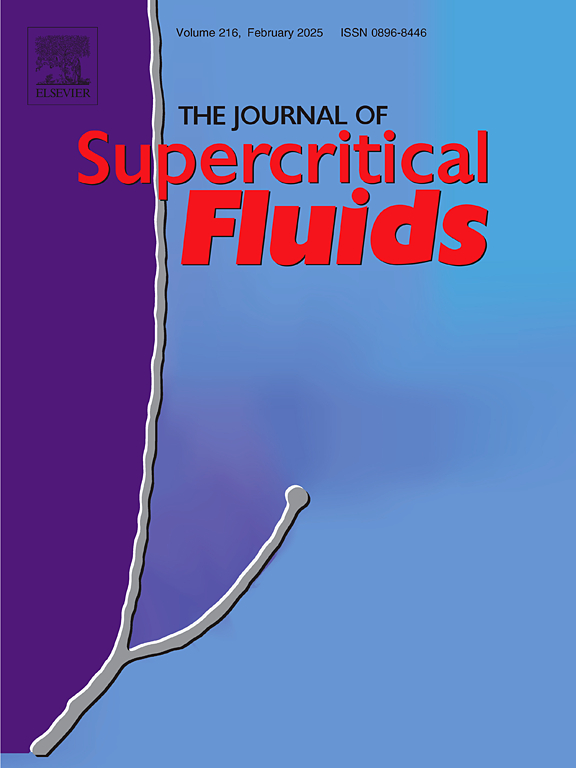Application of supercritical technology in the production of microparticles of bioactive compounds from apple pomace
IF 4.4
3区 工程技术
Q2 CHEMISTRY, PHYSICAL
引用次数: 0
Abstract
The study's objective was to evaluate the efficiency of supercritical assisted atomization (SAA) technology in encapsulating bioactive compounds extracted from apple pomace (AP), a by-product of the juice industry. Supercritical assisted atomization (SAA) was performed with extract to polymer ratios (1:5, 1:10, and 1:20), encapsulation used polyvinylpyrrolidone (PVP), and a sugar-removal method was applied. The results indicate that the 1:10 ratio presented superior results, with an average particle size of 1.67 ± 1.25 µm and a dispersion index 2.25. The antioxidant capacity was 2.55 µmol of Trolox/g of AP, and the content of phenolic compounds reached 2.18 mg of gallic acid equivalent (GAE)/g of AP. Despite reducing the bioactive compounds after encapsulation, the stability was significantly improved: 92 % of the antioxidant capacity and 99 % of the phenolic compounds were preserved after two months of exposure to light, while the non-encapsulated extract retained only 66 % and 71 %, respectively. HPLC analysis identified gallic acid (91.16–128.13 ppm) and ascorbic acid (111.12–153.67 ppm) as the main compounds. The work also includes the feasibility of this route as a strategy for sustainable valorization of apple pomace using the Path2Green metric to evaluate the process from the perspective of green chemistry. The sustainability assessment using the Path2Green method generated a score of 0.524, indicating the sustainable feasibility of the process. Encapsulation aimed to protect bioactive compounds, such as phenolics and antioxidants, from degradation, increasing their stability and bioactivity for applications in the food, pharmaceutical, and cosmetic industries.
超临界技术在苹果渣生产生物活性化合物微粒中的应用
该研究的目的是评估超临界辅助雾化(SAA)技术在封装从苹果渣(AP)中提取的生物活性化合物中的效率,AP是果汁工业的副产品。提取液与聚合物的比例分别为1:5、1:10和1:20,采用超临界辅助雾化(SAA),聚乙烯吡咯烷酮(PVP)包封,采用脱糖法。结果表明:以1:10的配比为优,平均粒径为1.67 ± 1.25 µm,分散指数为2.25。抗氧化能力为2.55µmol Trolox/g AP,酚类化合物含量达到2.18 mg没食子酸等效(GAE)/g AP。尽管包封后生物活性物质减少,但稳定性显著提高:光照两个月后,抗氧化能力和酚类化合物分别保留了92 %和99 %,而未包封的提取物分别仅保留了66 %和71 %。HPLC分析鉴定出主要化合物为没食子酸(91.16-128.13 ppm)和抗坏血酸(111.12-153.67 ppm)。这项工作还包括利用Path2Green指标从绿色化学的角度评估这一过程,将这条路线作为苹果渣可持续增值策略的可行性。采用Path2Green方法进行可持续性评估,得分为0.524,表明该过程具有可持续可行性。胶囊化旨在保护生物活性化合物,如酚类物质和抗氧化剂,防止降解,提高其稳定性和生物活性,用于食品,制药和化妆品行业。
本文章由计算机程序翻译,如有差异,请以英文原文为准。
求助全文
约1分钟内获得全文
求助全文
来源期刊

Journal of Supercritical Fluids
工程技术-工程:化工
CiteScore
7.60
自引率
10.30%
发文量
236
审稿时长
56 days
期刊介绍:
The Journal of Supercritical Fluids is an international journal devoted to the fundamental and applied aspects of supercritical fluids and processes. Its aim is to provide a focused platform for academic and industrial researchers to report their findings and to have ready access to the advances in this rapidly growing field. Its coverage is multidisciplinary and includes both basic and applied topics.
Thermodynamics and phase equilibria, reaction kinetics and rate processes, thermal and transport properties, and all topics related to processing such as separations (extraction, fractionation, purification, chromatography) nucleation and impregnation are within the scope. Accounts of specific engineering applications such as those encountered in food, fuel, natural products, minerals, pharmaceuticals and polymer industries are included. Topics related to high pressure equipment design, analytical techniques, sensors, and process control methodologies are also within the scope of the journal.
 求助内容:
求助内容: 应助结果提醒方式:
应助结果提醒方式:


